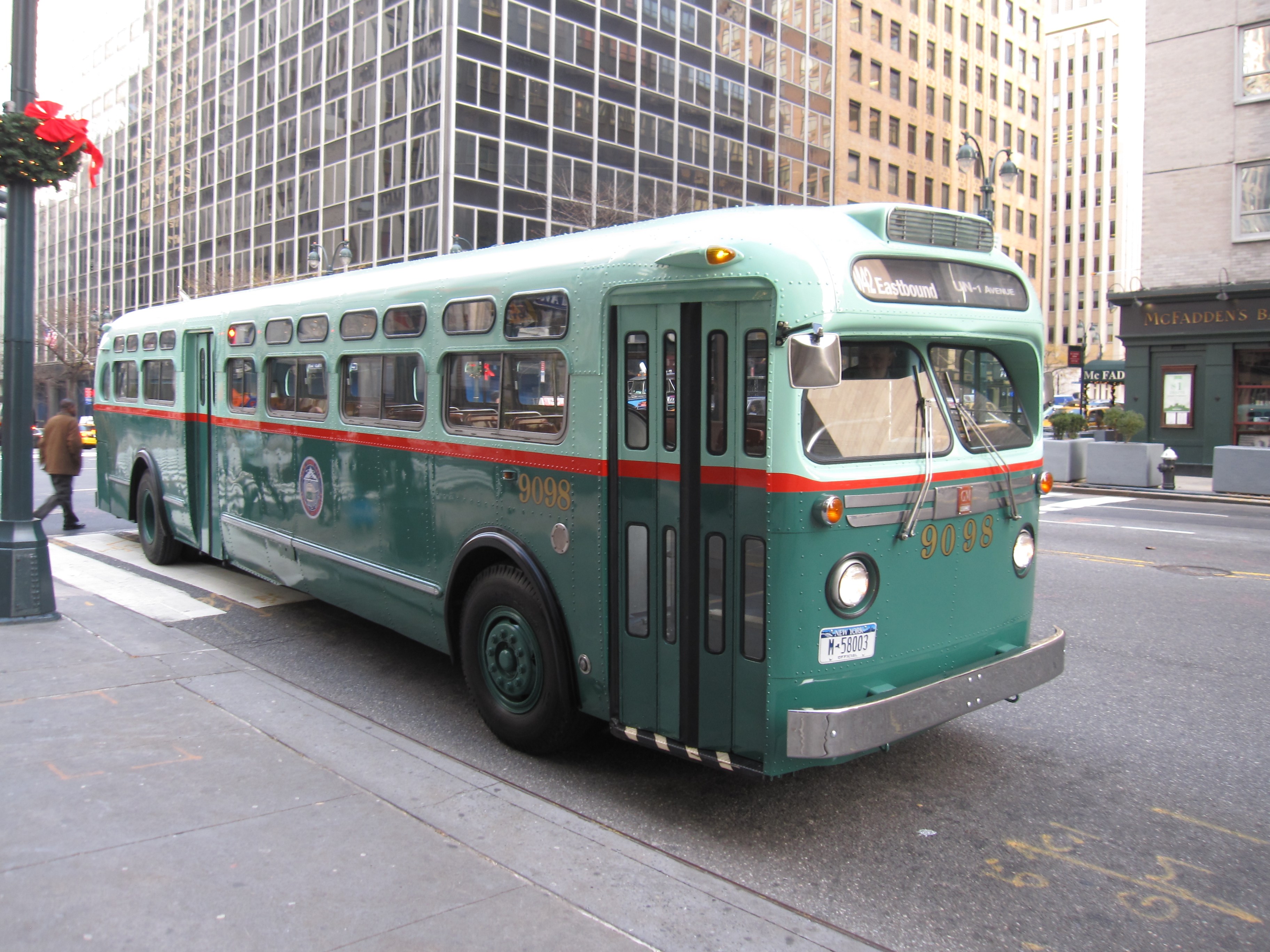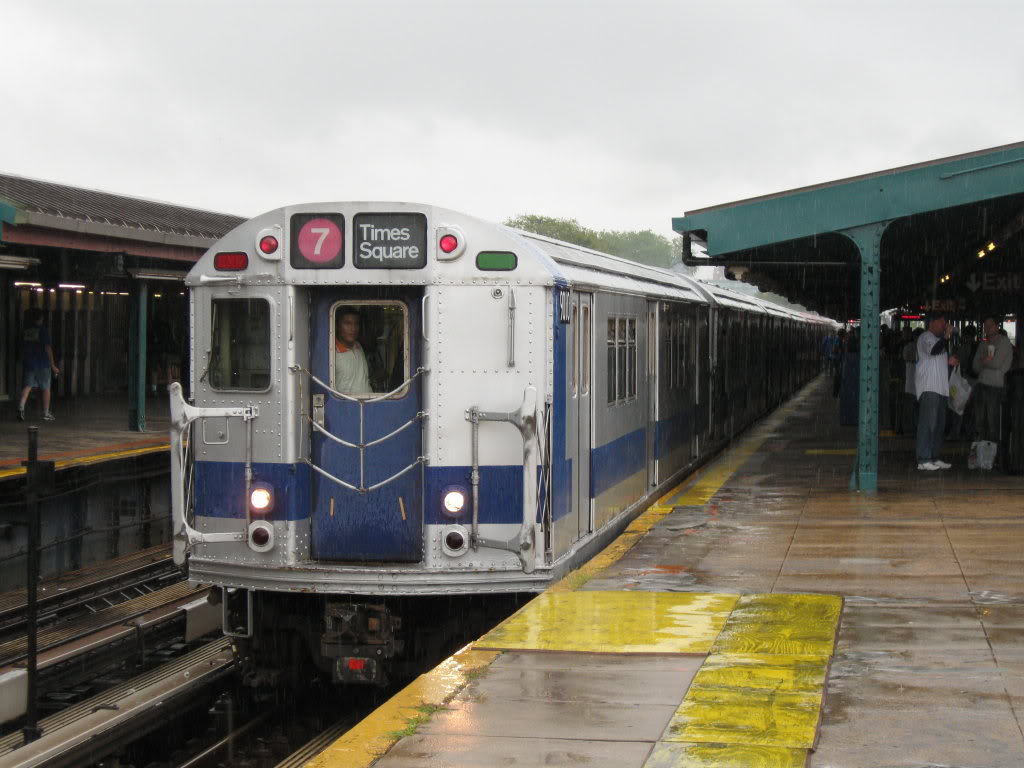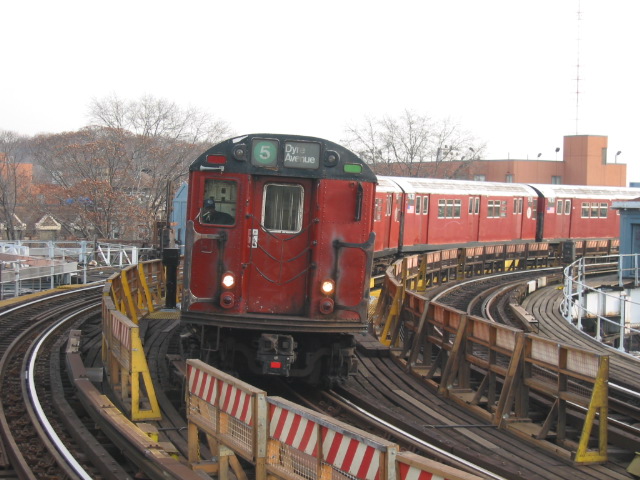|
R33 World's Fair (New York City Subway Car)
The R33S (also known as R33 World's Fair or R33WF) was a New York City Subway car that was built by St. Louis Car Company in 1963 for the IRT A Division. They were purchased for service on the IRT Flushing Line ( 7 and trains), which was the closest line to the 1964 New York World's Fair. A total of 40 cars were built, arranged as single cars. While in regular service, each R33S was coupled to five two-car consists of R36 cars to make 11-car trains for the 7 and routes. The R33S fleet entered service on September 26, 1963, and was originally painted in a light blue turquoise "Bluebird" scheme. The fleet was overhauled in the mid-1980s, during which the cars were painted red, leading to the nickname " Redbirds". The R33S fleet was replaced in the early 2000s with the delivery of the R142 and R142A cars, with the last train of R33S and R36s running on November 3, 2003. After being retired, some R33S cars were preserved, but most were kept for work service; many of the work ... [...More Info...] [...Related Items...] OR: [Wikipedia] [Google] [Baidu] |
Train Of Many Colors
The Train of Many Colors (also referred to as TOMC) is one of the New York Transit Museum's nostalgia trains used for excursions, which is made up of cars that were formerly used on Interborough Rapid Transit Company (IRT) lines. The name comes from the fact that the cars are painted in many varying schemes from different eras.http://www.mta.info/news/2013/07/10/lirr-provides-extra-service-all-star-game-events New York City Transit's 'Train of Many Colors' During the 2004 Subway Centennial, some of the cars were used for regular service on the 42nd Street Shuttle route. In addition, the cars may be used to commemorate a special occasion (e.g. the opening of CitiField in Queens). Some of the cars are housed in the New York Transit Museum when not used for excursions (R12, R15, R17, and R33S). Others are stored at the 207th Street Yard The New York City Transit Authority operates a total of 24 rail yards for the New York City Subway system, and one for the Staten Island Rail ... [...More Info...] [...Related Items...] OR: [Wikipedia] [Google] [Baidu] |
7d (New York City Subway Service)
The 7 Flushing Local and <7> Flushing Express are two rapid transit services in the A Division of the New York City Subway, providing local and express services along the full length of the IRT Flushing Line. Their route emblems, or "bullets", are colored , since they serve the Flushing Line. 7 trains operate at all times between Main Street in Flushing, Queens and 34th Street–Hudson Yards in Chelsea, Manhattan. Local service, denoted by a (7) in a circular bullet, operates at all times, while express service, denoted by a in a diamond-shaped bullet, runs only during rush hours and early evenings in the peak direction and during special events. The 7 route started running in 1915 when the Flushing Line opened. Since 1927, the 7 has held largely the same route, except for a one-stop western extension from Times Square to Hudson Yards on September 13, 2015. Service history Early history On June 13, 1915, the first test train on the IRT Flushing Line ran betwe ... [...More Info...] [...Related Items...] OR: [Wikipedia] [Google] [Baidu] |
New York City Transit Authority
The New York City Transit Authority (also known as NYCTA, the TA, or simply Transit, and branded as MTA New York City Transit) is a New York state public-benefit corporations, public-benefit corporation in the U.S. state of New York (state), New York that operates public transportation in New York City. Part of the Metropolitan Transportation Authority, the busiest and largest transit system in North America, the NYCTA has a daily ridership of 8million trips (over 2.5billion annually). The NYCTA operates the following systems: *New York City Subway, a rapid transit system in Manhattan, the Bronx, Brooklyn, and Queens. *Staten Island Railway, a rapid transit line on Staten Island (operated by the subsidiary Staten Island Rapid Transit Operating Authority) *New York City Bus, an extensive bus network serving all five boroughs, managed by MTA Regional Bus Operations. Name As part of establishing a common corporate identity, the Metropolitan Transportation Authority in 1994 assigned ... [...More Info...] [...Related Items...] OR: [Wikipedia] [Google] [Baidu] |
New York Transit Museum
The New York Transit Museum (also called the NYC Transit Museum) is a museum that displays historical artifacts of the New York City Subway, bus, and commuter rail systems in the greater New York City metropolitan region. The main museum is located in the decommissioned Court Street subway station in Downtown Brooklyn and Brooklyn Heights in the New York City borough of Brooklyn. There is a smaller satellite Museum Annex in Grand Central Terminal in Midtown Manhattan. The museum is a self-supporting division of the Metropolitan Transportation Authority. __TOC__ Historic use as station The museum is located in an actual subway station, which was originally called Court Street. The Court Street station was built as a terminus for local trains of the IND Fulton Street Line and opened on April 9, 1936, along with a long section of the Fulton Street Line and the Rutgers Street Tunnel. The station has one center island platform with two tracks. The tracks end at bumper blocks ... [...More Info...] [...Related Items...] OR: [Wikipedia] [Google] [Baidu] |
Coney Island Complex
The New York City Transit Authority operates a total of 24 rail yards for the New York City Subway system, and one for the Staten Island Railway. There are 10 active A Division yards and 11 active B Division yards, two of which are shared between divisions for storage and car washing. In addition, there is one yard for the Staten Island Railway and three non-revenue (Maintenance of Way, or MoW) Division-independent yards. Many of the system's yards are used for off-peak storage, whereas some have inspection facilities where basic routine maintenance is carried out. Of these yards, rolling stock are assigned to seven A Division yards and seven B Division yards. Within the yards are 14 maintenance facilities, whereas two yards (207th Street and Coney Island) perform major overhaul and car rebuilding work. A Division yards The A Division's yards consist of the 239th Street, 240th Street, Corona, East 180th Street, Jerome, Livonia, and Westchester maintenance yards, plus three oth ... [...More Info...] [...Related Items...] OR: [Wikipedia] [Google] [Baidu] |
Corona Yard
The New York City Transit Authority operates a total of 24 rail yards for the New York City Subway system, and one for the Staten Island Railway. There are 10 active A Division yards and 11 active B Division yards, two of which are shared between divisions for storage and car washing. In addition, there is one yard for the Staten Island Railway and three non-revenue (Maintenance of Way, or MoW) Division-independent yards. Many of the system's yards are used for off-peak storage, whereas some have inspection facilities where basic routine maintenance is carried out. Of these yards, rolling stock are assigned to seven A Division yards and seven B Division yards. Within the yards are 14 maintenance facilities, whereas two yards (207th Street and Coney Island) perform major overhaul and car rebuilding work. A Division yards The A Division's yards consist of the 239th Street, 240th Street, Corona, East 180th Street, Jerome, Livonia, and Westchester maintenance yards, plus three oth ... [...More Info...] [...Related Items...] OR: [Wikipedia] [Google] [Baidu] |
Facebook
Facebook is an online social media and social networking service owned by American company Meta Platforms. Founded in 2004 by Mark Zuckerberg with fellow Harvard College students and roommates Eduardo Saverin, Andrew McCollum, Dustin Moskovitz, and Chris Hughes, its name comes from the face book directories often given to American university students. Membership was initially limited to Harvard students, gradually expanding to other North American universities and, since 2006, anyone over 13 years old. As of July 2022, Facebook claimed 2.93 billion monthly active users, and ranked third worldwide among the most visited websites as of July 2022. It was the most downloaded mobile app of the 2010s. Facebook can be accessed from devices with Internet connectivity, such as personal computers, tablet computer, tablets and smartphones. After registering, users can create a profile revealing information about themselves. They can post text, photos and multimedia which are sha ... [...More Info...] [...Related Items...] OR: [Wikipedia] [Google] [Baidu] |
Anti-climber
A cowcatcher, also known as a pilot, is the device mounted at the front of a locomotive to deflect obstacles on the track that might otherwise damage or derail it or the train. In the UK small metal bars called ''life-guards'', ''rail guards'' or ''guard irons'' are provided immediately in front of the wheels. They knock away smaller obstacles lying directly on the running surface of the railhead. Historically, fenced-off railway systems in Europe relied exclusively on those devices and cowcatchers were not required, but in modern systems cowcatchers have generally superseded them. Instead of a cowcatcher, trams use a device called a fender. Objects lying on the tram track come in contact with a sensor bracket, which triggers the lowering of a basket-shaped device to the ground, preventing the overrunning of the obstacles and dragging them along the road surface in front of the wheels. In snowy areas the cowcatcher also has the function of a snowplough. Invention The cowc ... [...More Info...] [...Related Items...] OR: [Wikipedia] [Google] [Baidu] |
Graffiti
Graffiti (plural; singular ''graffiti'' or ''graffito'', the latter rarely used except in archeology) is art that is written, painted or drawn on a wall or other surface, usually without permission and within public view. Graffiti ranges from simple written words to elaborate wall paintings, and has existed since ancient times, with examples dating back to ancient Egypt, ancient Greece, and the Roman Empire. Graffiti is a controversial subject. In most countries, marking or painting property without permission is considered by property owners and civic authorities as defacement and vandalism, which is a punishable crime, citing the use of graffiti by street gangs to mark territory or to serve as an indicator of gang-related activities. Graffiti has become visualized as a growing urban "problem" for many cities in industrialized nations, spreading from the New York City subway system and Philadelphia in the early 1970s to the rest of the United States and Europe and other world ... [...More Info...] [...Related Items...] OR: [Wikipedia] [Google] [Baidu] |
Turquoise (color)
Turquoise ( ) is a blue-green color, based on the mineral of the same name. The word ''turquoise'' dates to the 17th century and is derived from the French , meaning 'Turkish', because the mineral was first brought to Europe through Turkey from mines in the historical Khorasan province of Iran (Persia) and Afghanistan. The first recorded use of ''turquoise'' as a color name in English was in 1573. The X11 color named turquoise is displayed on the right. Turquoise gemstones Turquoise is an opaque, blue-to-green mineral that is a hydrous phosphate of copper and aluminium, with the chemical formula Cu Al6( P O4)4(O H)8·4 H2O. It is rare and valuable in finer grades and has been prized as a gem and ornamental stone for thousands of years owing to its unique hue. In many cultures of the Old and New Worlds, this gemstone has been esteemed for thousands of years as a holy stone, a bringer of good fortune or a talisman. The oldest evidence for this claim was found ... [...More Info...] [...Related Items...] OR: [Wikipedia] [Google] [Baidu] |
R33 (New York City Subway Car)
The R33 was a New York City Subway car model that was built by St. Louis Car Company in 1962 and 1963. The cars are a "follow-up" or supplemental stock for the A Division's R29s and closely resemble them. The cars were also referred to as R33MLs (R33 Main Line) to distinguish them from the R33S's. A total of 500 cars were built, numbered 8806–9305, and arranged in pairs. The R33s entered service on November 15, 1962, and were the first A Division fleet to be retrofitted with air conditioning, being retrofitted between 1972 and 1982. The R33 fleet was overhauled between 1987 and 1991. The R33s were replaced in the early 2000s with the delivery of the R142 and R142A cars, with the last train running on April 20, 2003. After being retired, most R33s were sunk into the ocean as artificial reefs, but several cars have survived. Description The R33s were numbered 8806–9305. The cars were referred to as R33MLs (R33 Main Line) to distinguish them from the R33S's. The R33s ... [...More Info...] [...Related Items...] OR: [Wikipedia] [Google] [Baidu] |
Redbird Trains
Redbird trains were eight New York City Subway train models so-nicknamed because of their red paint. The Redbirds totaled 1,410 cars of the following types on the A Division lines: R26, R28, R29, R33, R33S, and R36. There were also 550 cars on the B Division lines: R27 and R30/A. All were built by the American Car and Foundry Company and the St. Louis Car Company. These cars were painted a deep red to combat graffiti, which had become a major problem in the late 1970s and early 1980s. The color was referred to as "Gunn Red" or "Broad Street Red" in honor of its originator David L. Gunn, the former SEPTA General Manager who became President of the New York City Transit Authority during this period. Initially entering service in various colors, these cars received the new paint scheme between 1984 and 1989. Sixteen R17s were also given this paint scheme in 1985 and 1986, but were retired by 1988, well before the name "Redbird" caught on. Today, repurposed Redbird cars ... [...More Info...] [...Related Items...] OR: [Wikipedia] [Google] [Baidu] |



.jpg)





